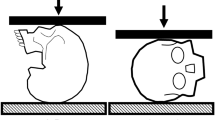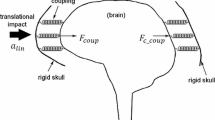Abstract
Real-time quantification of head impacts using wearable sensors is an appealing approach to assess concussion risk. Traditionally, sensors were evaluated for accurately measuring peak resultant skull accelerations and velocities. With growing interest in utilizing model-estimated tissue responses for injury prediction, it is important to evaluate sensor accuracy in estimating tissue response as well. Here, we quantify how sensor kinematic measurement errors can propagate into tissue response errors. Using previous instrumented mouthguard validation datasets, we found that skull kinematic measurement errors in both magnitude and direction lead to errors in tissue response magnitude and distribution. For molar design instrumented mouthguards susceptible to mandible disturbances, 150–400% error in skull kinematic measurements resulted in 100% error in regional peak tissue response. With an improved incisor design mitigating mandible disturbances, errors in skull kinematics were reduced to <50%, and several tissue response errors were reduced to <10%. Applying 30\(^{\circ }\) rotations to reference kinematic signals to emulate sensor transformation errors yielded below 10% error in regional peak tissue response; however, up to 20% error was observed in peak tissue response for individual finite elements. These findings demonstrate that kinematic resultant errors result in regional peak tissue response errors, while kinematic directionality errors result in tissue response distribution errors. This highlights the need to account for both kinematic magnitude and direction errors and accurately determine transformations between sensors and the skull.









Similar content being viewed by others
References
Bartsch A, Samorezov S, Benzel E, Miele V, Brett D (2014) Validation of an “intelligent mouthguard” single event head impact dosimeter. Stapp Car Crash J 58:1–27
Beckwith JG, Greenwald RM, Chu JJ (2012) Measuring head kinematics in football: correlation between the head impact telemetry system and Hybrid III headform. Ann Biomed Eng 40(1):237–248. doi:10.1007/s10439-011-0422-2. http://www.pubmedcentral.nih.gov/articlerender.fcgi?artid=3248620&tool=pmcentrez&rendertype=abstract
Broglio SP, Eckner JT, Martini D, Sosnoff JJ, Kutcher JS, Randolph C (2011) Cumulative head impact burden in high school football. J Neurotrauma 28(10):2069–2078. doi:10.1089/neu.2011.1825. http://www.ncbi.nlm.nih.gov/pmc/articles/PMC4346237/pdf/neu.2011.1825.pdf
Brolinson PG, Manoogian S, McNeely D, Goforth M, Greenwald R, Duma S (2006) Analysis of linear head accelerations from collegiate football impacts. Curr Sports Med Rep 5(1):23–28. http://www.ncbi.nlm.nih.gov/pubmed/16483513
Budday S, Sommer G, Birkl C, Langkammer C, Haybaeck J, Kohnert J, Bauer M, Paulsen F, Steinmann P, Kuhl E et al (2017) Mechanical characterization of human brain tissue. Acta Biomater 48:319–340
Camarillo DB, Shull PB, Mattson J, Shultz R, Garza D (2013) An instrumented mouthguard for measuring linear and angular head impact kinematics in American football. Ann Biomed Eng 41(9):1939–1949. doi:10.1007/s10439-013-0801-y. http://www.ncbi.nlm.nih.gov/pubmed/23604848
Campbell KR, Warnica MJ, Levine IC, Brooks JS, Laing AC, Burkhart TA, Dickey JP (2016) Laboratory evaluation of the gforce tracker, a head impact kinematic measuring device for use in football helmets. Ann Biomed Eng 44(4):1246–1256. doi:10.1007/s10439-015-1391-7
Crisco JJ, Fiore R, Beckwith JG, Chu JJ, Brolinson PG, Duma S, McAllister TW, Duhaime AC, Greenwald RM (2010) Frequency and location of head impact exposures in individual collegiate football players. J Athl Train 45(6):549–559. doi:10.4085/1062-6050-45.6.549. http://www.pubmedcentral.nih.gov/articlerender.fcgi?artid=2978006&tool=pmcentrez&rendertype=abstract
Elliott MR, Margulies SS, Maltese MR, Arbogast KB (2015) Accounting for sampling variability, injury under-reporting, and sensor error in concussion injury risk curves. J Biomech 48(12):3059–3065. doi:10.1016/j.jbiomech.2015.07.026. http://linkinghub.elsevier.com/retrieve/pii/S0021929015004194
Forte AE, Galvan S, Manieri F, y Baena FR, Dini D (2016) A composite hydrogel for brain tissue phantoms. Mater Des 112:227–238
Forte AE, Gentleman SM, Dini D (2017) On the characterization of the heterogeneous mechanical response of human brain tissue. Biomech Model Mechanobiol 16(3):907–920
Gabler LF, Crandall JR, Panzer MB (2016) Assessment of kinematic brain injury metrics for predicting strain responses in diverse automotive impact conditions. Ann Biomed Eng 44(12):3705–3718. doi:10.1007/s10439-016-1697-0
Giordano C, Kleiven S (2014) Evaluation of axonal strain as a predictor for mild traumatic brain injuries using finite element modeling. Stapp Car Crash J 58(14):29–61
Hardy WN, Mason MJ, Foster CD, Shah CS, Kopacz JM, Yang KH, King AI, Bishop J, Bey M, Anderst W et al (2007) A study of the response of the human cadaver head to impact. Stapp Car Crash J 51:17
Hernandez F, Wu LC, Yip MC, Laksari K, Hoffman AR, Lopez JR, Grant GA, Kleiven S, Camarillo DB (2015) Six degree-of-freedom measurements of human mild traumatic brain injury. Ann Biomed Eng 43(8):1918–1934. doi:10.1007/s10439-014-1212-4
Hrapko M, Van Dommelen JAW, Peters GWM, Wismans JSHM (2008) Characterisation of the mechanical behaviour of brain tissue in compression and shear. Biorheology 45(6):663–676. doi:10.3233/BIR-2008-0512
Jadischke R, Viano DC, Dau N, King AI, McCarthy J (2013) On the accuracy of the Head Impact Telemetry (HIT) System used in football helmets. J Biomech 46(13):2310–2315. doi:10.1016/j.jbiomech.2013.05.030. http://www.ncbi.nlm.nih.gov/pubmed/23891566
Ji S, Ghadyani H, Bolander RP, Beckwith JG, Ford JC, McAllister TW, Flashman LA, Paulsen KD, Ernstrom K, Jain S, Raman R, Zhang L, Greenwald RM (2014a) Parametric comparisons of intracranial mechanical responses from three validated finite element models of the human head. Ann Biomed Eng 42(1):11–24. doi:10.1007/s10439-013-0907-2. http://www.ncbi.nlm.nih.gov/pubmed/24077860
Ji S, Zhao W, Li Z, McAllister TW (2014b) Head impact accelerations for brain strain-related responses in contact sports: a model-based investigation. Biomech Model Mechanobiol 13(5):1121–1136. doi:10.1007/s10237-014-0562-z
Ji S, Zhao W, Ford JC, Beckwith JG, Bolander RP, Greenwald RM, La Flashman, Paulsen KD, Mcallister TW (2015) Group-wise evaluation and comparison of white matter fiber strain and maximum principal strain. J Neurotrauma 14:1–14. doi:10.1089/neu.2013.3268
Kleiven S (2006) Evaluation of head injury criteria using a finite element model validated against experiments on localized brain motion, intracerebral acceleration, and intracranial pressure. Int J Crashworthines 11(1):65–79. doi:10.1533/ijcr.2005.0384. http://www.tandfonline.com/doi/abs/10.1533/ijcr.2005.0384
Kleiven S (2007) Predictors for traumatic brain injuries evaluated through accident reconstructions. Stapp Car Crash J 51:81
Kleiven S, Hardy WN (2002) Correlation of an FE model of the human head with local brain motion–consequences for injury prediction. Stapp Car Crash J 46(November):123–144. http://www.ncbi.nlm.nih.gov/pubmed/17096222
Kroshus E, Baugh CM, Daneshvar DH, Viswanath K (2014a) Understanding concussion reporting using a model based on the theory of planned behavior. J Adolesc Health 54(3):269–274.e2. doi:10.1016/j.jadohealth.2013.11.011. http://linkinghub.elsevier.com/retrieve/pii/S1054139X13007696
Kroshus E, Kubzansky LD, Goldman RE, Austin SB (2014b) Norms, athletic identity, and concussion symptom under-reporting among male collegiate ice hockey players: a prospective cohort study. Ann Behav Med 49(1):95–103. doi:10.1007/s12160-014-9636-5. http://link.springer.com/10.1007/s12160-014-9636-5
Kuo C, Wu LC, Hammoor BT, Luck JF, Cutcliffe HC, Lynall RC, Kait JR, Campbell KR, Mihalik JP, Bass CR, Camarillo DB (2016) Effect of the mandible on mouthguard measurements of head kinematics. J Biomech 49:1845–1853. doi:10.1016/j.jbiomech.2016.04.017
Langlois JA, Rutland-Brown W, Wald MM (2006) The epidemiology and impact of traumatic brain injury: a brief overview. J Head Trauma Rehabil 21(5):375–378. http://www.ncbi.nlm.nih.gov/pubmed/16983222
Mittenberg W, Strauman S (2000) Diagnosis of mild head injury and the postconcussion syndrome. J Head Trauma Rehabil 15(2):783–791. http://www.ncbi.nlm.nih.gov/pubmed/10739967
Nicolle S, Lounis M, Willinger R, Palierne JF (2005) Shear linear behavior of brain tissue over a large frequency range. Biorheology 42(3):209–223. http://www.ncbi.nlm.nih.gov/pubmed/15894820
Patton DA, Mcintosh AS, Kleiven S (2015) The biomechanical determinants of concussion: finite element simulations to investigate tissue-level predictors of injury during sporting impacts to the unprotected head, pp 264–268. doi:10.1123/jab.2014-0223
Prevost TP, Balakrishnan A, Suresh S, Socrate S (2011) Biomechanics of brain tissue. Acta Biomater 7(1):83–95. doi:10.1016/j.actbio.2010.06.035
Rowson S, Beckwith JG, Chu JJ, Leonard DS, Greenwald RM, Duma SM (2011) A six degree of freedom head acceleration measurement device for use in football. J Appl Biomech 27(1):8–14
Rowson S, Duma SM, Beckwith JG, Chu JJ, Greenwald RM, Crisco JJ, Brolinson PG, Duhaime AC, McAllister TW, Maerlender AC (2012) Rotational head kinematics in football impacts: an injury risk function for concussion. Ann Biomed Eng 40(1):1–13. doi:10.1007/s10439-011-0392-4
SAE (1995) SAE J211–1 (1995): Instrumentation for impact test, part 1. Electron Instrum 552:25. doi:10.1520/G0154-12A
Siegmund GP, Guskiewicz KM, Marshall SW, DeMarco AL, Bonin SJ (2014) A headform for testing helmet and mouthguard sensors that measure head impact severity in football players. Ann Biomed Eng 42(9):1834–1845. doi:10.1007/s10439-014-1052-2. http://www.ncbi.nlm.nih.gov/pubmed/24920257
Siegmund GP, Guskiewicz KM, Marshall SW, DeMarco AL, Bonin SJ (2016) Laboratory validation of two wearable sensor systems for measuring head impact severity in football players. Ann Biomed Eng 44(4):1257–1274. doi:10.1007/s10439-015-1420-6
Smith DH, Meaney DF (2000) Axonal damage in traumatic brain injury. Porg Clin Neurosci 6(6):483–492
Sullivan S, Eucker SA, Gabrieli D, Bradfield C, Coats B, Maltese MR, Lee J, Smith C, Margulies SS (2015) White matter tract-oriented deformation predicts traumatic axonal brain injury and reveals rotational direction-specific vulnerabilities. Biomech Model Mechanobiol 14(4):877–896. doi:10.1007/s10237-014-0643-z. http://link.springer.com/10.1007/s10237-014-0643-z
Takhounts EG, Eppinger RH, Campbell JQ, Tannous RE (2003) On the development of the SIMon finite element head model. Stapp Car Crash J 47:107
Takhounts EG, Ridella SA, Hasija V, Tannous RE, Campbell JQ, Malone D, Danelson K, Stitzel J, Rowson S, Duma S (2008) Investigation of traumatic brain injuries using the next generation of simulated injury monitor (SIMon) finite element head model. Stapp Car Crash J 52(November):1
Takhounts EG, Ridella SA, Rowson S, Duma SM (2010) Kinematic rotational brain injury criterion (BRIC). In: Enhanced safety of vehicles, pp 1–10
Wright RM, Ramesh KT (2012) An axonal strain injury criterion for traumatic brain injury. Biomech Model Mechanobiol 11(1–2):245–260. doi:10.1007/s10237-011-0307-1. http://www.ncbi.nlm.nih.gov/pubmed/21476072
Wu LC, Laksari K, Kuo C, Luck JF, Kleiven S, Dale’ Bass CR, Camarillo DB (2016a) Bandwidth and sample rate requirements for wearable head impact sensors. J Biomech 39(0):2918–2924. doi:10.1016/j.jbiomech.2016.07.004. http://linkinghub.elsevier.com/retrieve/pii/S0021929016307448
Wu LC, Nangia V, Bui K, Hammoor B, Kurt M, Hernandez F, Kuo C, Camarillo DB (2016b) In vivo evaluation of wearable head impact sensors. Ann Biomed Eng 44(4):1234–1245. doi:10.1007/s10439-015-1423-3. arXiv:1503.03948
Zhao W, Ford JC, Flashman LA, McAllister TW, Ji S (2016) White matter injury susceptibility via fiber strain evaluation using whole-brain tractography. J Neurotrauma 33(20):1834–1847. doi:10.1089/neu.2015.4239
Zhao W, Cai Y, Li Z, Ji S (2017a) Injury prediction and vulnerability assessment using strain and susceptibility measures of the deep white matter. Biomech Model Mechanobiol. doi:10.1007/s10237-017-0915-5
Zhao W, Kuo C, Wu L, Camarillo DB, Ji S (2017b) Performance evaluation of a pre-computed brain response atlas in dummy head impacts. Ann Biomed Eng 1–14
Acknowledgements
This study was supported by the National Institutes of Health (NIH), National Institute of Biomedical Imaging and Bioengineering (NIBIB) 3R21EB01761101S1, the Stanford Child Health Research Institute Transdisciplinary Initiatives Program, and the Stanford Bio-X Graduate Research Fellowship Program. Additional funding was provided by the NIH Grants R01 NS092853 and R21 NS088781.
Author information
Authors and Affiliations
Corresponding author
Rights and permissions
About this article
Cite this article
Kuo, C., Wu, L., Zhao, W. et al. Propagation of errors from skull kinematic measurements to finite element tissue responses. Biomech Model Mechanobiol 17, 235–247 (2018). https://doi.org/10.1007/s10237-017-0957-8
Received:
Accepted:
Published:
Issue Date:
DOI: https://doi.org/10.1007/s10237-017-0957-8




